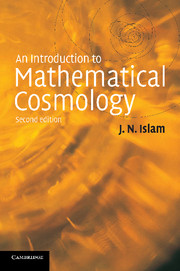Book contents
- Frontmatter
- Contents
- Preface to the first edition
- Preface to the second edition
- Dedication
- 1 Some basic concepts and an overview of cosmology
- 2 Introduction to general relativity
- 3 The Robertson–Walker metric
- 4 The Friedmann models
- 5 The Hubble constant and the deceleration parameter
- 6 Models with a cosmological constant
- 7 Singularities in cosmology
- 8 The early universe
- 9 The very early universe and inflation
- 10 Quantum cosmology
- 11 The distant future of the universe
- Appendix
- Bibliography
- Index
11 - The distant future of the universe
Published online by Cambridge University Press: 03 February 2010
- Frontmatter
- Contents
- Preface to the first edition
- Preface to the second edition
- Dedication
- 1 Some basic concepts and an overview of cosmology
- 2 Introduction to general relativity
- 3 The Robertson–Walker metric
- 4 The Friedmann models
- 5 The Hubble constant and the deceleration parameter
- 6 Models with a cosmological constant
- 7 Singularities in cosmology
- 8 The early universe
- 9 The very early universe and inflation
- 10 Quantum cosmology
- 11 The distant future of the universe
- Appendix
- Bibliography
- Index
Summary
Introduction
In the previous chapters we have considered in some detail the ‘standard’ model of the universe. It is pertinent to ask what the prediction of the standard model is for the distant future of the universe. The future of the universe has been the subject of much speculation, in one form or another, from time immemorial. It is only in the last few decades that enough progress has been achieved in cosmology to study this question scientifically. In this chapter we shall attempt to provide an account of – or at any rate limit the possibilities for – the distant future of the universe, on the basis of the present state of knowledge. We refer the reader to Rees (1969), Davies (1973), Islam (1977, 1979a,b, 1983a,b), Barrow and Tipler (1978) and Dyson (1979) for more material on this topic. This chapter is based mostly on the papers by Islam and Dyson.
The distant future of the universe is dramatically different depending on whether it expands forever, or it stops expanding at some future time and recollapses. In the earlier chapters we have considered in detail the conditions under which these possibilities are likely to arise. As galaxies are the basic constituents of the universe, to examine the distant future of the universe we must consider the long term evolution of a typical galaxy. We will first assume that we are in an open universe, or, at any rate, that an indefinite time in the future is available.
- Type
- Chapter
- Information
- An Introduction to Mathematical Cosmology , pp. 211 - 219Publisher: Cambridge University PressPrint publication year: 2001

